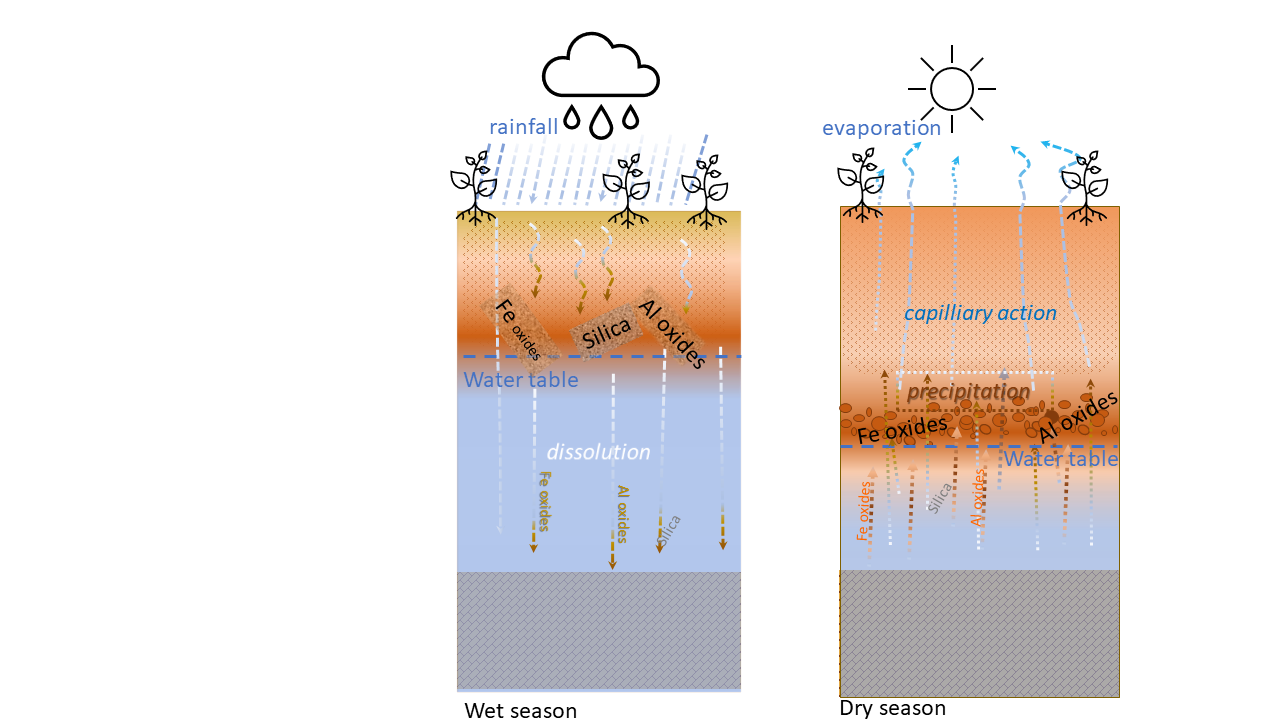|
|
Substrate (including geology and soils)In wetland and aquatic ecology, substrate includes the sediment, soil, bedrock and other material, either biotic or abiotic, that comprises the floor or bed of the sea, a lake, river or wetland[4]. Substrate is important for animals, plants, ecosystems and people in many different ways. For animals and plants, the substrate is a secure living space for attachment and shelter, providing a refuge from predators, extremes of temperature, wind and water, a food source, and a source of nutrients and freshwater. Substrates are important for many key ecosystem processes, providing a foundation for living ecosystems, regulating groundwater and surface water interactions, tidal pumping and chemical exchange between the land and the sea, soil formation and nutrient processing. Substrates also deliver services that people value, such as filtering water, buffering coastlines from weather and wave energy, providing building materials, providing sandy beaches and rocky headlands for recreation and aesthetic values, islands, beaches and tidal flats, and are an essential part of areas of spiritual and cultural significance. Quick facts
Physical characteristics of substrateCharacteristics of the substrate include:
Substrates are subject to change or variability. Geological, geomorphological and physical processes (e.g. compaction) play an important role in substrate consolidation and substrate grain size, and chemical processes (e.g. certain geological or soil-forming processes) influence substrate composition and lithology. For more information about these processes, see the rock cycle and geology/lithology. Some variable properties that apply to substrates include:
Chemical characteristics of substrateNutrients and other chemical compounds such as carbon, nitrogen, phosphourus, oxygen, iron and potassium exist in substrate such as soils and sediment. Chemical compounds in substrates may change due to weathering, and some elements are insoluble. The presence of chemicals can affect the erositivity and productivity of the substrate. Mineral and chemical composition of substrate strongly influences the type of soil that can develop. Salinity can be natural in soils and can be linked to soil degradation, including soil erosion. Chemical processes include dissolution, chemical precipitation/cementation, recrystallization, or formation of concretions or nodules. An example of a chemical process in sediments is induration, which involves dissolution and precipitation. Dissolved iron and aluminium oxides percolate through the soil layers and solidifies as an indurated layer during deep weathering processes such as laterisation. Cementation results when crystals grow within the pore spaces of sediments. Cementation of unconsolidated substrates can be irregular, such as nodules or concretions, or form regular bands of rock of intermediate consolidation such as beach rock or coffee rock. CarbonSubstrates (particularly soils and sediments) can store, cycle and emit different forms of carbon as part of the carbon cycle. Soils store more carbon than the atmosphere and plants combined[5][1][3]. Wetland soils are characterised by having high levels of carbon, and can form peats in certain circumstances. Organic carbon in soils is comprimsed of decaying plant matter, soil organisms and microbes. Inorganic carbon is mineral based (such as calcium carbonate). Carbon and organic matter in soil provides energy and nutrient storage. Soils are better able to hold water with more organic material and resist acidification[5], by increasing pH buffering capacity. Organic carbon supports soil structure by binding particles into aggregates, increases water infiltration and prevents losses of nutrients. Soil cultivation and soil degradation can impact organic carbon levels, by disturbing the soil and removal of plant residue. More information and links: Carbon processes and cycle - WetlandInfo Wetlands and the carbon cycle - WetlandInfo Soil carbon - Queensland Government Soil carbon sequestration - NSW Department of Primary Industries Carbon cycle and budgets - State of the Environment Soil Organic Matter- Department of Natural Resources and Environment Tasmania NitrogenNitrogen in sediment and soil is crucial for their health and productivity. Nitrogen can accumulate via sediment into wetlands, can be stored in organic matter (immobilisation) and undergo processes where it is transformed into other nitrogen compounds which plants and bacteria can use. Storage of nitrogen is important as it contributes to soil health and productivity of plants (such as mangroves). Nitrous oxide (N2O) is a greenhouse gas that is released from soils in repsonse to weather events, changes in soil (due to land use) or released through denitrification. Comprehensive information on Nitrogen processes and forms is available here and in The Nitrogen Books. Pages under this sectionReferences
Last updated: 6 September 2023 This page should be cited as: Department of Environment, Science and Innovation, Queensland (2023) Substrate (including geology and soils), WetlandInfo website, accessed 18 March 2024. Available at: https://wetlandinfo.des.qld.gov.au/wetlands/ecology/components/substrate/ |

 — Department of Environment, Science and Innovation
— Department of Environment, Science and Innovation


